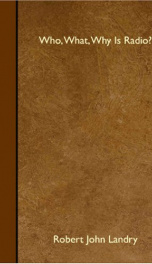who what why is radio

It emerges now into a troubled world. The people of all nations wonder, fairly, if there is inherent within the human race enough intelligence to protect itself in the end from the consequences of its own talents in one phase of development-the scientific laboratory phase. Do we possess the sheer brain capacity to devise ethics to match the destructive forces which have just been so eloquently dramatized in the buzz-bomb and the atom bomb Bring these two inventions together, the radio-controlled flying torpedo and the deadly chemical formula which releases atomic energy-and the means exist for the suicide of the human race. All this adds up to saying that the conscience of the world needs to be kept on permanent alert. Only education and an enlightened public opinion can hope to keep the world peaceful. The moral is obvious one of the great media of communication i. e. education is radiobroadcasting. What, then, is American radio like Mr. Landrys provocative survey of the who-what-why has been widely read and quoted since its first appearance and now, the text partly revised to bring it up to date, it is re-issued because of the persistent demand for the work. It is not a lengthy volume. This Radio House vii series is planned to provide readers with concise, factpacked, perspective-providing statements on various aspects of a complex modern phenomenon. Who, What, Why is Radio as the lead-off book in the series has suggested the tone and indicated the design of the whole. At the time of its first publication Mr. Landrys book was warmly received by. the press. Time called the volume benignant but free from bunk and added that as an introduction to broadcasting and as a try at a sound point of view on the subject it has few predecessors and no up-to-date rivals. Advertisi zg d Selling Magazine esteemed Who, what, Why is Radio in these words the most cogent description yet written of the growth and deveIopment of radio. To the extent that any volume dealing with an expanding and constantly changing art can be a standard text, we believe that it is apt to so represent Mr. Landrys work. We proudly offer this revised edition. The Publishers. CONTENTS Editors Foreword I. WHO I. The Regulators 2. The Broadcasters 3. The Advertisers 11. WHAT 4. Folkways 5 . Techniques 6. Attitudes 111. m y 7. Problems 8. Neighbors 9. Critics 10. Prophets Postlude ix vii I WHO THE REGULATORS THE VASTNESS of American radio needs to be emphasized. There are g I 5 radio stations, four coast-to-coast networks, 25 regional networks. Stations operate 17 and 18 hours a day. Programs parade past four and five abreast from before daylight to after midnight. In New York City aloile there are 20 stations. There are 16 in Chicago, 12 in Los Angeles, eight in Boston. Over two-thirds of the stations are afiiliated with national or regional networks. During the day the stations intermittently join or leave these chains, losing or gaining in the process a national, a regional or a local complexion. Thus is provided to the American public a many-sided, many-sized, diverse, diffuse, far-flung, non-stop broadcasting service. Sonletimes it is demagogic, sometimes bucolic, on occasion mildly pedagogic. In its finer moments it is dynamic. It represents perhaps a sort of democratic splendor, a trifle clouded. Big and devious and various, it is not easy to gain a full perspective on American radio. Nor is it surprising to learn that the preoccupied radio specialist often sees only his own small niche...
Info about the book
Author:
Series:
Unknown
ISBN:
0470225564
Rating:
3/5 (4)Your rating:
0/5
Languge:
English
Users who have this book
Users who want this book
What readers are saying
What do you think? Write your own comment on this book!
write a commentif you like who what why is radio try:
Other books by this author
Do you want to exchange books? It’s EASY!
Get registered and find other users who want to give their favourite books to good hands!

